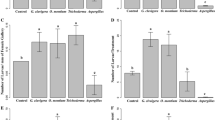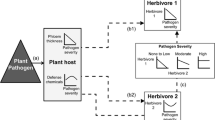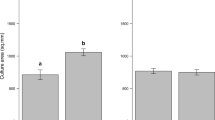Abstract
Despite overlap in niches, two fungal symbionts of the mountain pine beetle (Dendroctonus ponderosae), Grosmannia clavigera and Ophiostoma montium, appear to coexist with one another and their bark beetle host in the phloem of trees. We sampled the percent of phloem colonized by fungi four times over 1 year to investigate the nature of the interaction between these two fungi and to determine how changing conditions in the tree (e.g., moisture) affect the interaction. Both fungi colonized phloem at similar rates; however, G. clavigera colonized a disproportionately larger amount of phloem than O. montium considering their relative prevalence in the beetle population. High phloem moisture appeared to inhibit fungal growth shortly after beetle attack; however, by 1 year, low phloem moisture likely inhibited fungal growth and survival. There was no inverse relationship between the percent of phloem colonized by G. clavigera only and O. montium only, which would indicate competition between the species. However, the percent of phloem colonized by G. clavigera and O. montium together decreased after 1 year, while the percent of phloem from which no fungi were isolated increased. A reduction in living fungi in the phloem at this time may have significant impacts on both beetles and fungi. These results indicate that exploitation competition occurred after a year when the two fungi colonized the phloem together, but we found no evidence of strong interference competition. Each species also maintained an exclusive area, which may promote coexistence of species with similar resource use.





Similar content being viewed by others
References
Adams AS, Six DL (2007) Temporal variation in mycophagy and prevalence of fungi associated with developmental stages of the mountain pine beetle, Dendroctonus ponderosae (Coleoptera: Curculionidae). Environ Entomol 36:64–72
Adams AS, Six DL (2008) In vitro interactions among yeasts, bacteria and the fungal symbionts of the mountain pine beetle, Dendroctonus ponderosae. Microb Ecol (in press) DOI 10.1007/s00248-008-9364-0
Barras SJ (1973) Reduction of progeny and development in the southern pine beetle following removal of symbiotic fungi. Can Entomol 105:1295–1299
Bleiker KP, Six DL (2007) Dietary benefits of fungal associates to an eruptive herbivore: Potential implications of multiple associates on host population dynamics. Environ Entomol 36:1384–1396
Bridges JR, Perry TJ (1985) Effects of mycangial fungi on gallery construction and distribution of bluestain in southern pine beetle Dendroctonus frontalis infested pine bolts. J Entomol Sci 20:271–275
Coppedge BR, Stephen FM, Felton GW (1995) Variation in female southern pine beetle size and lipid content in relation to fungal associates. Can Entomol 127:145–154
Croise L, Dreyer E, Lieutier F (1998) Effects of drought stress and severe pruning on the reaction zone induced by single inoculations with a bark beetle associated fungus (Ophiostoma ips) in the phloem of young Scots pines. Can J For Res 28:1814–1824
Gause GF (1934) The struggle for existence. Williams & Wilkins, Baltimore
Goldhammer DS, Stephen FM, Paine TM (1990) The effect of the fungi Ceratocystis minor, Ceratocystis minor var. barassii and SJB 122 on reproduction of the southern pine beetle, Dendroctonus frontalis. Can Entomol 122:407–418
Graham K (1967) Fungal-insect mutualism in trees and timber. Ann Rev Entomol 12:105–126
Harrington TC (1981) Cycloheximide sensitivity as a taxonomic character in Ceratocystis. Mycologia 73:926–1129
Harrington TC (2005) Ecology and evolution of mycophagous bark beetles and their fungal partners. In: Vega FE, Blackwell M (eds) Insect–fungal associations: Ecology and evolution. Oxford University Press, New York, pp 257–291
Hofstetter RW, Mahfouz J, Klepzig K, Ayres MP (2005) Effects of tree phytochemistry on the interactions among endophloedic fungi associated with the southern pine beetle. J Chem Ecol 31:539–560
Hofstetter RW, Cronin JT, Klepzig KD, Moser JC, Ayres MP (2006) Antagonisms, mutualisms and commensalisms affect outbreak dynamics of the southern pine beetle. Oecologia 147:679–691
Hofstetter RW, Klepzig KD, Moser JC, Ayres MP (2006) Seasonal dynamics of mites and fungi and their interaction with southern pine beetle. Environ Entomol 35:22–30
Hofstetter RW, Dempsey TD, Klepzig KD, Ayres MP (2007) Temperature-dependence of symbiotic interactions among fungi, mites and the southern pine beetle. Community Ecol 8:47–56
Hölttä T, Vesala T, Sevanto S, Perämäki M, Nikinmaa E (2006) Modeling xylem and phloem water flows in trees according to cohesion theory and Munch hypothesis. Trees 20:67–78
Keddy PA (1989) Competition. Chapman & Hall, New York
Kim JJ, Allen EA, Humble LM, Breuil C (2005) Ophiostomatoid and basidiomycetous fungi associated with green, red, and grey lodgepole pines after mountain pine beetle (Dendroctonus ponderosae) infestation. Can J For Res 35:274–284
Klepzig KD, Six DL (2004) Bark beetle–fungal symbiosis: Context dependency in complex associations. Symbiosis 37:189–205
Klepzig KD, Wilkens RT (1997) Competitive interactions among symbiotic fungi of the southern pine beetle. Appl Environ Microbiol 63:621–627
Klepzig KD, Flores-Otero J, Hofstetter RW, Ayres MP (2004) Effects of available water on growth and competition of southern pine beetle associated fungi. Mycol Res 108:183–188
Leach JG, Orr LW, Christensen C (1934) The interrelationships of bark beetles and blue-stain fungi in felled Norway pine timber. J Agri Res 49:315–342
Lee S, Kim JJ, Breuil C (2006) Diversity of fungi associated with the mountain pine beetle, Dendroctonus ponderosae, and infested lodgepole pines in British Columbia. Fungal Divers 22:91–105
Lombardero MJ, Ayres MP, Hofstetter RW, Moser JC, Klepzig KD (2003) Strong indirect interactions of Tarsonemus mites (Acarina: Tarsonemidae) and Dendroctonus frontalis (Coleoptera: Scolytidae). Oikos 102:243–252
Miller RH, Whitney HS, Berryman AA (1986) Effects of induced translocation stress and bark beetle attack Dendroctonus ponderosae on heat pulse velocity and the dynamic wound response of lodgepole pine Pinus contorta var. latifolia. Can J Bot 64:2669–2674
Paine TD, Raffa KF, Harrington TC (1997) Interactions among scolytid bark beetles, their associated fungi and live host conifers. Annu Rev Entomol 42:179–206
Raffa KF, Berryman AA (1982) Physiological differences between lodgepole pines resistant and susceptible to the mountain pine beetle and associated microorganisms. Environ Entomol 11:486–492
Reid RW (1961) Moisture changes in lodgepole pine before and after attack by mountain pine beetle. For Chron 37:368–375
Reid RW, Shrimpton DM (1971) Resistant response of lodgepole pine to inoculation with Europhium clavigerum in different months and at different heights on stem. Can J Bot 49:349–351
Rice AV, Thormann MN, Langor DW (2007) Mountain pine beetle-associated blue-stain fungi are differentially adapted to boreal temperatures. For Pathol 38(2):113–123
Safranyik L, Carroll AL (2006) The biology and epidemiology of the mountain pine beetle in lodgepole pine forests. In: Safranyik L, Wilson B (eds) The mountain pine beetle: A synthesis of biology, management and impacts on lodgepole pine. Natural Resources Canada, Victoria, pp 3–66
Schoener TW (1976) Alternatives to Lotka Volterra Competition Models of Intermediate Complexity. Theor Popul Biol 10:309–333
Scriber JM, Slansky F Jr. (1981) The nutritional ecology of immature insects. Annu Rev Entomol 26:183–211
Seifert KA (1993) Sapstain of commercial lumber by species of Ophihostoma and Ceratocystis. In: Wingfield MJ, Seifert KA, Webber JF (eds) Ceratocystis and Ophiostoma: Taxonomy, ecology and pathogenicity. APS Press, St. Paul, pp 141–151
Shearer CA (1995) Fungal competition. Can J Bot 73:S1259–S1264
Six DL, Paine T (1998) Effects of mycangial fungi and host tree species on progeny survival and emergence of Dendroctonus ponderosae (Coleoptera: Scolytidae). Environ Entomol 27:1393–1401
Six DL (2003) A comparison of mycangial and phoretic fungi of individual mountain pine beetles. Can J For Res 33:1331–1334
Six DL (2003) Bark beetle–fungus symbioses. In: Bourtzis K, Miller TA (eds) Insect Symbiosis. CRC, New York, pp 97–114
Six DL, Bentz BJ (2007) Temperature determines symbiont abundance in a multipartite bark beetle–fungus ectosymbiosis. Microb Ecol 54:112–118
Sokal RR, Rohlf FJ (2000) Biometry. W.H. Freeman, New York
Solheim H (1995) Early stages of blue-stain fungus invasion of lodgepole pine sapwood following mountain pine beetle attack. Can J Bot 73:70–74
Solheim H, Krokene P (1998) Growth and virulence of mountain pine beetle associated blue stain fungi, Ophiostoma clavigerum and Ophiostoma montium. Can J Bot 76:561–566
Upadhyay HP (1981) A monograph of Ceratocystis and Ceratocystiopsis. University of Georgia Press, Athens
Whitney HS, Farris SH (1970) Maxillary mycangium in the mountain pine beetle. Science 167:54–55
Whitney HS (1971) Association of Dendroctonus ponderosae (Coleoptera: Scolytidae) with blue stain fungi and yeasts during brood development in lodgepole pine. Can Entomol 103:1495–1503
Acknowledgements
We thank D. Higginson for field assistance and E. Crone for statistical advice. The manuscript was improved by reviews from B. Bentz, C. Fiedler, J. Maron, D. Emlen and K. Milner. This research was conducted as part of Regional Research Project W-187 and was funded by the McIntire-Stennis Cooperative Forestry Program and the University of Montana.
Author information
Authors and Affiliations
Corresponding author
Rights and permissions
About this article
Cite this article
Bleiker, K.P., Six, D.L. Competition and Coexistence In a Multi-partner Mutualism: Interactions Between two Fungal Symbionts of the Mountain Pine Beetle In Beetle-attacked Trees. Microb Ecol 57, 191–202 (2009). https://doi.org/10.1007/s00248-008-9395-6
Received:
Revised:
Accepted:
Published:
Issue Date:
DOI: https://doi.org/10.1007/s00248-008-9395-6




